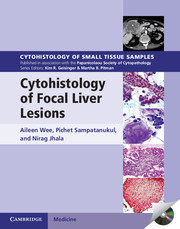Book contents
- Frontmatter
- Dedication
- Contents
- CONTRIBUTING AUTHOR
- Preface
- 1 The focal liver lesion: general considerations
- 2 Morphologic approach
- 3 Diagnostic algorithm
- 4 Focal liver lesions with low or no suspicion of malignancy
- 5 Focal liver lesions suspicious of hepatocellular carcinoma
- 6 Focal liver lesions suspicious of intrahepatic cholangiocarcinoma
- 7 Focal liver lesions from metastases and other malignancies
- 8 Focal liver lesions with cystic appearance
- 9 Focal liver lesions in infants and children
- 10 Ancillary studies
- 11 Techniques and technology in practice
- Index
6 - Focal liver lesions suspicious of intrahepatic cholangiocarcinoma
Published online by Cambridge University Press: 05 April 2015
- Frontmatter
- Dedication
- Contents
- CONTRIBUTING AUTHOR
- Preface
- 1 The focal liver lesion: general considerations
- 2 Morphologic approach
- 3 Diagnostic algorithm
- 4 Focal liver lesions with low or no suspicion of malignancy
- 5 Focal liver lesions suspicious of hepatocellular carcinoma
- 6 Focal liver lesions suspicious of intrahepatic cholangiocarcinoma
- 7 Focal liver lesions from metastases and other malignancies
- 8 Focal liver lesions with cystic appearance
- 9 Focal liver lesions in infants and children
- 10 Ancillary studies
- 11 Techniques and technology in practice
- Index
Summary
INTRODUCTION
Cholangiocarcinoma (CC) is a malignancy of biliary epithelium and is classified into intrahepatic, hilar, and extrahepatic types. Intrahepatic cholangiocarcinoma (ICC) is the second most common primary carcinoma in the liver after hepatocellular carcinoma (HCC). ICC can arise anywhere within the intrahepatic bile ducts. Those originating in the smallest bile ducts and ductules are sometimes referred to as “peripheral ICCs,” as opposed to those “central ICCs” arising from the bigger ducts proximal to the hepatic bile ducts. However, both terms are not in favor and should be discouraged. Hilar CC, also known as “Klatskin tumor,” arises from the right and left hepatic ducts at or near their junction. Since hilar CC has specific features more akin to extrahepatic CC, it is dealt with separately in “Hilar cholangiocarcinoma.”
The incidence of ICC in Northeastern Thailand where the liver fluke, Opisthorchis viverrini, is endemic is 96:100000, compared with the worldwide incidence of 2:100000. The clinical management of patients hailing from this area (called E-sarn in the local language) differs greatly from other parts of the world. An E-sarn native presenting with a liver mass is deemed clinically to have ICC until proven otherwise. Clonorchis sinensis is the other fluke responsible for the majority of CCs in the Far East in the last century.
The radiologic features of ICC are categorized according to the gross morphology, namely, mass-forming (MF), periductal-infiltrating (PI), and intraductal-growth (IG) types. Biopsies, either fine needle aspiration biopsy (FNAB) or core needle biopsy (CNB), are usually required to verify the diagnosis. However, it is generally accepted that the cytohistologic diagnosis of ICC, which is basically an adenocarcinoma, needs clinical correlation and exclusion of malignancies from other sites. The authors, from their review of surgical resections and biopsies of ICCs from Thai patients, have observed certain consistent characteristics of interest which will be highlighted.
- Type
- Chapter
- Information
- Cytohistology of Focal Liver Lesions , pp. 139 - 170Publisher: Cambridge University PressPrint publication year: 2000



